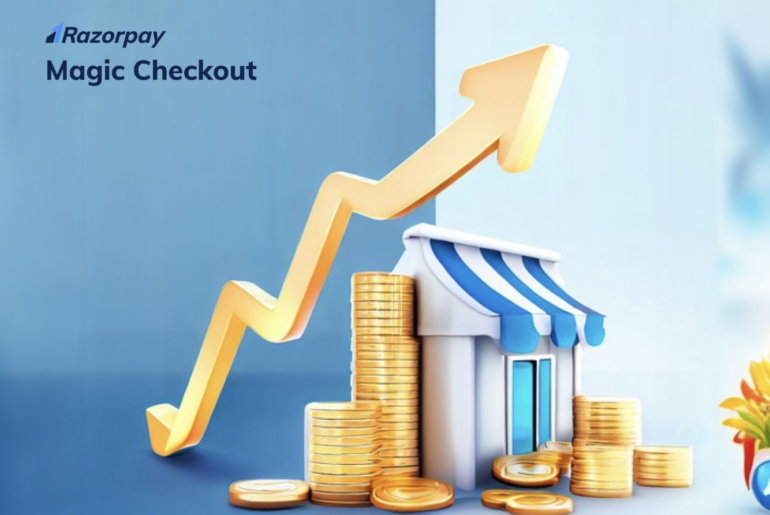E-commerce Growth: Nurturing Success from Seed to Summit
‘E-commerce growth’ isn’t just a phrase; it’s a journey that takes a tiny seed of an idea and cultivates it into a towering success story. Much like the nurturing of a young plant, this path involves deliberate care, strategic attention, and an unwavering focus on the future.
In the pages that follow, we navigate this terrain of ‘e-commerce growth,’ guiding you through the pivotal milestones, ingenious strategies, and crucial breakthroughs that define this remarkable journey. Join us as we dive into the very heart of ‘e-commerce growth,’ unraveling its essence and equipping you with the tools to transform aspirations into achievements.
Table of Contents
E-Commerce Growth- What’s the Need?
Growth is the cornerstone of long-term success in the world of e-commerce. It’s not a mere option but a fundamental strategy that underpins the sustainability and growth of businesses. And here are a few reasons why every e-commerce business aspires to grow higher:
Ensure Sustainable Growth: Expansion in operations, customer base, and revenue is vital for maintaining competitiveness in a rapidly evolving market.
Enhance Market Resilience: E-commerce growth fosters resilience to market fluctuations and uncertainties by creating diversified revenue streams and a broader customer base.
Unlock Efficiency and Cost Savings: Business growth often presents opportunities for operational efficiencies, bulk purchasing power, and optimized logistics, leading to increased profit margins.
Attract Investment and Partnerships: Demonstrating growth potential enhances credibility and attractiveness to investors and potential partners, paving the way for collaborative opportunities.
Respond to Customer Demands: E-commerce growth enables businesses to meet evolving customer expectations by introducing new products, services, and features, ensuring a competitive edge in the market.
Outpace the Competition: In the fiercely competitive e-commerce landscape, effective growth allows businesses to surpass rivals and establish themselves as market leaders.
 E-commerce Market Size in India
E-commerce Market Size in India
The e-commerce market in India has witnessed exponential growth, evolving from a nascent sector to a behemoth industry. Owing to the increasing internet user base and favorable market conditions, India possesses immense potential in the e-commerce industry. In 2018, the market value of the e-commerce industry in India was approximately 22 billion U.S. dollars. However, this is just the beginning of its journey. Projections indicate that this number is estimated to reach a staggering 350 billion U.S. dollars by the year 2030, showcasing the incredible e-commerce growth trajectory of the Indian e-commerce landscape.
E-commerce Platforms in India
Navigating the e-commerce scene in India is like being in a competitive battlefield. Many local and foreign companies are trying to grab a piece of the profitable market. In April 2017, Amazon India became the top player, making over 500 million U.S. dollars in sales. At the same time, Flipkart and Myntra, big names in the local market, still had a strong presence.
Consumer Perspective
In a survey conducted in May 2020, which sought public opinion on permitting e-commerce platforms to deliver goods in India following the coronavirus lockdown, the majority of respondents expressed their resounding approval. This shows that many people see e-commerce as a crucial part of how Indians live today, and they trust it as a reliable and easy way to shop.
Future Outlook
The future of India’s e-commerce market looks very promising. With a strong and growing internet user base and favorable market conditions, the industry is on an exceptional growth path. This growth will be driven by ongoing technological innovations, expansions in logistics networks, and increased reach into tier-II and tier-III cities.
Additionally, by 2026, global e-commerce retail sales are projected to reach an estimated 9.4 trillion U.S. dollars. This underscores the tremendous scale and impact of the e-commerce sector on a global level.
Building a Solid Foundation
In the fast-paced world of e-commerce, success is often rooted in the strength of your foundation. A solid base serves as the bedrock upon which your online business can flourish.
 Establishing the Bedrock for Growth
Establishing the Bedrock for Growth
To lay the groundwork for robust e-commerce growth, start by:
Defining Your Vision: Clearly define your business goals and objectives. Understand where you want your e-commerce venture to be in the short and long term.
Market Research: Conduct thorough market research to identify your target audience, competition, and market trends. This knowledge will sharpen your strategy. The extent of your market investigation is within your control, and it’s essential to factor in key elements like:
- Digital Market Presence: Understand where your business stands in relation to the overall market in the digital realm.
- Competitive Landscape: Assess the level of competition within a specific market, crucial for estimating the necessary resources.
- Identifying Key Players: Determine the number and scale of significant players in the industry to gain insights into your competition and devise innovative strategies.
- Market Magnitude: Recognize that a potential market of 1,000 people differs significantly from one with a million. The size of the market plays a pivotal role in delineating its potential and impacts your strategic considerations.
Related Read: What are the Different Types of Digital Wallets?
Finding Products to Sell: Offer products based on the pain points of your target audience. Consider conducting surveys or market research to gain insights into customer preferences and pain points and stay attuned to market trends and innovations. Focus on selling products that genuinely help your customers.
Financial Planning: Create a realistic budget and financial plan. This includes estimating startup costs, setting pricing strategies, and projecting revenue.
Legal Compliance: Ensure that your e-commerce business complies with all legal requirements, such as business registration, taxation, and industry-specific regulations.
Technology Stack: Choose the right e-commerce platform and technology stack that suits your business needs. Consider factors like scalability, ease of use, and available features.
The Credibility Checklist
To enhance your website’s credibility, consider the following steps:
High-Quality Content: Provide detailed product descriptions, including specifications, benefits, and usage instructions. Use professional product images and videos to showcase your offerings.
Customer Reviews: Encourage customers to leave reviews and ratings for your products. Respond to both positive and negative feedback promptly and professionally.
Secure Payment Options: Implement secure and trusted payment gateways to protect customer financial data. Display trust badges, SSL certificates, and secure checkout symbols prominently.
Transparent Policies: Clearly communicate return, refund, and shipping policies to customers. Transparency builds trust and reduces hesitation during the purchasing process.
Easy Contact: Make it easy for customers to reach out with questions or concerns. Offer live chat, email, and phone support options.
Related Read: What is an SSL Certificate & How To Install an SSL Certificate?
Harnessing Marketplace Potential for Brand Building
To leverage marketplaces for e-commerce growth and brand building:
Strategic Selection of E-Commerce Marketplaces: Choose the right marketplaces that align with your target audience and products. Figure out which e-commerce marketplace targets your audience, assess the platform’s user-friendliness, and analyze whether these marketplaces meet your requirements.
- Audience Fit: Assess the demographics and preferences of the audience on different platforms. Opt for a marketplace where your target customers are more likely to shop.
- Product Compatibility: Some platforms may be better suited for specific types of products or industries. Ensure that the platform supports the nature of your products and aligns with your business model.
- User-Friendly Interface: Evaluate the usability and interface of the e-commerce platforms. A user-friendly experience is crucial for attracting and retaining customers.
- Scalability: Choose a platform that can grow with your business. Consider the scalability of the e-commerce solution to accommodate increased product listings, higher traffic, and expanded operations.
- Costs and Fees: Understand the fee structure of each platform, including listing fees, transaction fees, and any additional costs. Factor these into your financial planning to ensure profitability.
- Features and Customization: Assess the features and customization options offered by each platform. Select one that provides the tools and flexibility you need to showcase your products effectively.
Branding Consistency: Maintain consistent branding across all platforms, including logos, product listings, and messaging. This consistent branding reinforces brand recognition and supports e-commerce growth.
Customer Engagement: Engage with customers on marketplace platforms by promptly responding to queries, providing exceptional customer service, and addressing issues professionally. This customer-centric approach is key to fostering e-commerce growth.
Optimize Listings: Create detailed and optimized product listings, including high-quality images and compelling descriptions. Utilize relevant keywords for better visibility and enhanced e-commerce growth opportunities.
The Art of Flawless Website Design
Crafting an exceptional website design involves the following steps:
User-Centric Design: Prioritize a user-centric design, ensuring that the layout and structure are built with the user’s experience in mind. Make navigation intuitive by organizing content logically, and ensure that information is easy to find. Conduct usability testing to identify and address any potential pain points that users may encounter.
Mobile Responsiveness: Optimize your website for mobile devices, as a significant portion of users shop on smartphones and tablets.
Loading Speed: Improve website loading speed by optimizing images, minimizing HTTP requests, and using content delivery networks (CDNs). A faster loading time enhances the user experience and positively impacts search engine rankings.
Consistent Branding: Maintain a consistent color scheme, typography, and imagery throughout your website to reinforce brand identity.
Defining Your Brand Positioning, Target Audience, and Pricing Strategy
To foster e-commerce growth, consider these vital strategies:
Brand Positioning
- Start by meticulously defining your brand’s unique value proposition, ensuring it aligns with your goals for e-commerce growth. Understand what makes your brand stand out from competitors and identify the core values that resonate with your target audience.
- Craft a compelling brand story that not only communicates your products or services but also creates an emotional connection with your audience, ultimately driving e-commerce growth through a distinct and memorable identity.
Target Audience
- Achieving substantial e-commerce growth begins with thorough research to identify and understand your target audience or ideal customers. Develop detailed buyer personas that go beyond basic demographics, diving into their preferences, behaviors, and pain points.
- Tailor your marketing efforts to address the specific needs and challenges of your target audience. This personalized approach not only enhances customer engagement but also fosters brand loyalty, contributing significantly to e-commerce growth.
Pricing Strategy
Determine the ideal pricing strategy for your products, recognizing its critical role in achieving e-commerce growth. Consider various factors, including production costs, competitor pricing, and perceived value by your customers.
Striking the right balance between competitiveness and profitability is essential for sustainable e-commerce growth. Regularly reassess and adjust your pricing strategy as market conditions evolve to ensure that it aligns with both customer expectations and your business objectives. A well-calibrated pricing strategy can drive sales, customer satisfaction, and long-term e-commerce growth.
Related Read: What Is E-Commerce Marketing? Types, Strategies & Tips
Foster Ongoing Customer Relationships
Building lasting connections with your customers is a cost-effective strategy that holds immense value for e-commerce businesses. According to a study, acquiring a new customer can cost six to seven times more than retaining existing ones. While new customer acquisition is crucial, cultivating repeat business is even more efficient, and there are innovative methods to achieve this.
Give Incentives to Loyal Customers: Move beyond traditional practices by extending incentives not only to new customers but also to loyal ones. Offering discounts and additional perks to returning customers goes a long way in establishing trust and solidifying long-term relationships.
Implement Loyalty Programs: Implementing loyalty programs is a powerful strategy to encourage customers to frequently visit your website and deepen their connections with your brand. Rewarding customers for their continued support fosters a sense of loyalty that extends beyond individual transactions.
Personalized Recommendations: Leverage the effectiveness of personalized communication. Craft tailored emails that include product recommendations based on a customer’s recent purchase. A study by Dyspatch and SurveyMonkey revealed that personalized emails with relevant product suggestions are highly favored by audiences, making them a valuable tool in nurturing customer engagement and repeat business.
Streamlining Conversions: The Checkout Experience
To optimize the checkout process for higher conversions and boost e-commerce growth:
Guest Checkout: Allow customers to make purchases without creating an account. Guest checkout simplifies the process for first-time buyers.
Multiple Payment Options: Offer a variety of payment methods, including credit/debit cards, digital wallets, and UPI, to cater to diverse customer preferences.
Clear Progress Indicators: Provide a step-by-step progress indicator during checkout so customers know how many steps are left before completion.
Order Confirmation: Send immediate order confirmation emails with order details and shipping information. Keep customers informed about their purchases.
Try Razorpay Magic Checkout: Consider implementing solutions such as Razorpay Magic Checkout, a solution designed to transform your checkout process while enhancing customer satisfaction. With this cutting-edge tool, your checkout process becomes not just faster but 5X more efficient.
Magic Checkout swiftly identifies risky orders using advanced algorithms, aiding informed order fulfillment decisions. By automatically disabling Cash on Delivery (COD) for high Return to Origin (RTO) risk users, it simplifies operations and minimizes return complexities. Additionally, Magic Checkout ensures the accuracy of customer details through address validation, thereby fortifying overall operational efficiency. Moreover, Magic Checkout conveniently displays preferred payment methods on a single screen.
Also Read: Fire-Boltt Increased its Order Conversion Rate by 50%
Optimizing Operations for E-commerce Growth
Streamlining Inventory Management, Order Processing, and Fulfillment to Foster E-commerce Growth
Inventory Management: Efficiently manage your inventory to minimize stockouts and overstock situations, which is crucial for e-commerce growth. Implement inventory tracking systems to monitor stock levels in real-time. Utilize demand forecasting to optimize stock replenishment
Order Processing: Streamline your order processing workflow to enhance e-commerce growth. Invest in order management software that can automate order entry, tracking, and status updates. This reduces manual errors and accelerates order fulfillment.
Fulfillment Strategies: Evaluate your fulfillment methods, whether in-house or through third-party logistics providers. Choose options that align with your business’s scalability and customer expectations. Efficient fulfillment ensures timely deliveries and customer satisfaction, essential for e-commerce growth.
Leveraging Automation Tools for Enhanced Efficiency and E-commerce Growth
Customer Relationship Management (CRM): Implement a CRM system to manage customer interactions and data essential for e-commerce growth. Automate email marketing, customer segmentation, and personalized communication to enhance customer engagement.
Inventory Management Software: Utilize advanced inventory management software that automates stock tracking, order routing, and reordering processes. This minimizes human errors and optimizes inventory levels.
Marketing Automation: Automate marketing tasks such as email campaigns, social media posting, abandoned cart recovery notifications, and ad retargeting to fuel e-commerce growth. Marketing automation tools help you reach the right audience at the right time, driving conversions.
Data Analytics: Leverage data analytics tools to gain insights into customer behavior, sales trends, and operational efficiency. Data-driven decision-making can identify areas for improvement and growth opportunities.
 Customer Acquisition Strategies
Customer Acquisition Strategies
Exploring Diverse Customer Acquisition Channels
SEO (Search Engine Optimization): Optimize your website and content for search engines to increase organic traffic and attract potential customers.
PPC (Pay-Per-Click Advertising): Run targeted paid ad campaigns on platforms like Google Ads to capture the attention of users actively searching for your products or services.
Social Media Marketing: Leverage the power of social platforms like Facebook, Instagram, and Twitter to engage with your audience, build brand awareness, and drive traffic to your website.
Influencer Partnerships: Collaborate with influencers in your industry or niche to tap into their engaged followers and gain credibility.
Creating a Cohesive Omnichannel Experience
Seamless Integration: In today’s digital era, most brands start online. As your brand matures and achieves Product-Market Fit (PMF), consider expanding into offline channels for enhanced reach and engagement.To maintain trust and loyalty, ensure consistent branding and messaging across all channels, creating a seamless omnichannel experience.
Data Utilization: Leverage customer data to personalize interactions and recommendations across various channels, enhancing the overall shopping experience.
Building a High-Performance Team
E-commerce growth hinges on the prowess of a skilled team. In this competitive landscape, innovation and adaptability are essential, and a proficient team brings these qualities to the forefront. Hiring strategies must emphasize alignment with your brand’s vision and culture, ensuring that top talent is on board.
1. Marketing Team: Orchestrating User Acquisition and Beyond
Your marketing team is the vanguard for user acquisition, wielding the power of data-driven strategies, persuasive content creation, and a keen grasp of social media dynamics. Beyond acquisition, they foster engagement and brand loyalty, nurturing long-term e-commerce growth.
2. Operations Team: The Backbone of Efficiency
The operations team operates behind the scenes, orchestrating seamless supply chain management, inventory control, and logistics. Their meticulous attention to detail ensures that orders are fulfilled promptly, enhancing customer satisfaction.
3. Strategy Team: Architects of Success
Strategists play a pivotal role in charting the course of e-commerce growth. They analyze market trends, competitor landscapes, and consumer behavior to develop innovative strategies that position your brand ahead of the curve.
4. Product Team: Crafting Customer-Centric Excellence
A customer-centric approach is paramount, and your product team is tasked with translating this vision into reality. They innovate, refine, and optimize product offerings to meet customer needs and expectations.
5. Research and Development: Pioneers of Innovation
Innovation is the lifeblood of sustained success, and the R&D team thrives on pushing boundaries. They explore emerging technologies, experiment with new features, and drive continuous improvement.
6. Tech Wizards: Enablers of Seamless User Experiences
Tech-savvy professionals are responsible for crafting and maintaining the digital infrastructure that enables seamless user experiences. Their work ensures that your e-commerce platform remains fast, secure, and user-friendly.
7. Business Analytics: Data-Driven Decision-Making
Data is the currency of modern business, and business analysts mine it for invaluable insights. They crunch numbers, identify trends, and inform strategic decisions that drive success.
8. Customer Support: Building Trust and Loyalty
Exceptional customer support is the linchpin of e-commerce growth. These professionals are friendly faces and helpful voices that address inquiries, resolve issues, and nurture trust and loyalty among your customer base.
9. Human Resources: Cultivating Talent
Behind every high-performing team is an HR department that identifies, recruits, and retains top talent. Their role in building a cohesive, motivated, and skilled workforce is paramount for sustained success.
10. Leadership: Guiding the Way
Ultimately, the success of your high-performance team rests on effective leadership. Leaders set the vision, foster a culture of innovation, and provide the guidance needed to navigate the ever-evolving landscape of success.
 Challenges and Solutions
Challenges and Solutions
Managing Increased Demand
As e-commerce businesses grow, the surge in demand can strain resources, lead to stockouts, and impact customer satisfaction. Effective demand forecasting and inventory management systems are vital solutions. Implement automation to streamline order processing and consider outsourcing fulfillment to third-party providers for scalability.
Maintaining Quality
With business growth comes quality control challenges, risking the consistency of products or services. Invest in rigorous quality assurance processes and employee training programs to uphold standards. Monitor customer feedback closely and implement iterative improvements based on insights.
Avoiding Overexpansion
Rapid growth can tempt businesses to expand into new markets or product lines prematurely, risking financial instability. Conduct market research and feasibility studies before expanding. Focus on optimizing existing operations and achieving sustainable profitability before diversifying.
Strategies for Overcoming Challenges
- Clear Growth Milestones and Resource Allocation: Begin by establishing well-defined growth milestones that align with your business objectives. Allocate resources strategically to support these milestones, ensuring that your expansion is both sustainable and well-paced. Regularly review and adjust these milestones as needed to adapt to changing market conditions.
- Robust Analytics and Performance Monitoring: Implement sophisticated analytics and reporting tools to gain deep insights into your e-commerce operations. Continuously monitor key performance metrics such as conversion rates, customer acquisition costs, and inventory turnover. These insights will empower data-driven decision-making, helping you identify areas for improvement and optimization.
- Cultivate a Culture of Adaptability and Continuous Improvement: Encourage a culture of adaptability and innovation within your team. Emphasize the importance of agility and the willingness to embrace change. Foster an environment where team members feel empowered to propose and implement improvements. Regularly assess and iterate on processes to enhance efficiency and quality.
- Collaboration with Industry Peers: Recognize the value of collaborating with industry peers and partners. Join relevant industry associations, attend conferences, and engage in networking opportunities. These interactions can provide valuable insights into emerging trends, best practices, and innovative solutions. Sharing knowledge with others in the field can spark new ideas and strategies for overcoming common challenges.
 Measuring and Evaluating Growth
Measuring and Evaluating Growth
Customer Acquisition Cost (CAC): Maximizing Efficiency
CAC is the cost associated with acquiring a new customer. Understanding this metric enables you to assess the effectiveness of your marketing campaigns and customer acquisition strategies. Lowering CAC while maintaining or increasing revenue is a clear sign of sustainable growth.
Customer Lifetime Value (CLV): Fostering Customer Loyalty
CLV represents the total revenue a customer is expected to generate over their lifetime as your client. A high CLV indicates that your e-commerce business excels in retaining customers and maximizing their value over time. It’s a key metric for assessing the long-term sustainability of your growth.
Market Share: Evaluating Your Position
Your e-commerce business doesn’t exist in a vacuum; it operates within a broader market. Monitoring your market share helps you understand your competitive standing. An increase in market share signifies that you are capturing a more significant portion of your industry, which is a strong indicator of growth.
The Power of Data-Driven Decision-Making
Making informed decisions based on data is the cornerstone of successful e-commerce growth. Relying on data ensures that your strategies are rooted in real-world insights rather than guesswork.
Tools to Help You Measure and Master E-Commerce Metrics
Google Analytics
Metrics: Revenue, CAC, CLV
Use: Google Analytics provides detailed insights into website traffic, user behavior, and conversion rates. It can help track revenue generated from online sales, acquisition channels, and user demographics.
Kissmetrics
Metrics: CLV
Use: Kissmetrics is a powerful tool for tracking and analyzing customer behavior, allowing you to calculate CLV based on user actions, purchase history, and engagement.
SEMrush
Metrics: Market Share
Use: SEMrush provides competitive intelligence and helps analyze your position in the market compared to your competitors. It offers insights into keywords, traffic, and market share.
Facebook Ads Manager
Metrics: CAC
Use: If you use Facebook for advertising, the Ads Manager provides detailed data on ad performance, allowing you to calculate CAC for campaigns and target audiences.
Hotjar
Metrics: User Behavior (e.g., click tracking, heatmaps)
Use: Hotjar allows you to understand how users interact with your website, helping you make data-driven decisions to improve user experience and conversion rates.
Shopify Analytics (for Shopify users)
Metrics: Revenue, CAC, CLV
Use: Shopify’s built-in analytics tools are tailored for e-commerce businesses. They provide insights into sales, traffic sources, and customer behavior.
Tableau
Metrics: Revenue, CAC, CLV, Market Share
Use: Tableau is a powerful data visualization tool that can help you create customized dashboards and reports to analyze and visualize your e-commerce data, including revenue, customer metrics, and market share.
Excel/Google Sheets
Metrics: Revenue, CAC, CLV, Market Share
Use: These spreadsheet tools can help you create customized spreadsheets to calculate and visualize key metrics such as revenue, CAC, CLV, and even market share. Their flexibility allows you to tailor your analysis to your specific e-commerce business needs.
Wrapping Up
Throughout this exploration, we’ve traversed the intricate terrain of e-commerce growth, uncovering its essence and equipping you with the essential tools to transform aspirations into tangible achievements. Let’s recap the key takeaways from this journey:
✅Understanding the Need for E-Commerce Growth
✅E-commerce Market Size in India
✅Building a Solid Foundation
✅Optimizing Operations for E-commerce Growth
✅Customer Acquisition Strategies
✅Building a High-Performance Team
✅Challenges and Solutions
✅Measuring and Evaluating Growth
As you set sail on your own e-commerce growth voyage, embrace each growth opportunity with unwavering enthusiasm, skillfully adapt to the ever-evolving market landscape, and steadfastly adhere to the guiding light of data-driven decision-making. Remember, success in the e-commerce world isn’t just about reaching the top; it’s about mastering the journey with determination and resilience. Embrace this adventure, and may your e-commerce endeavor surpass your highest aspirations.



